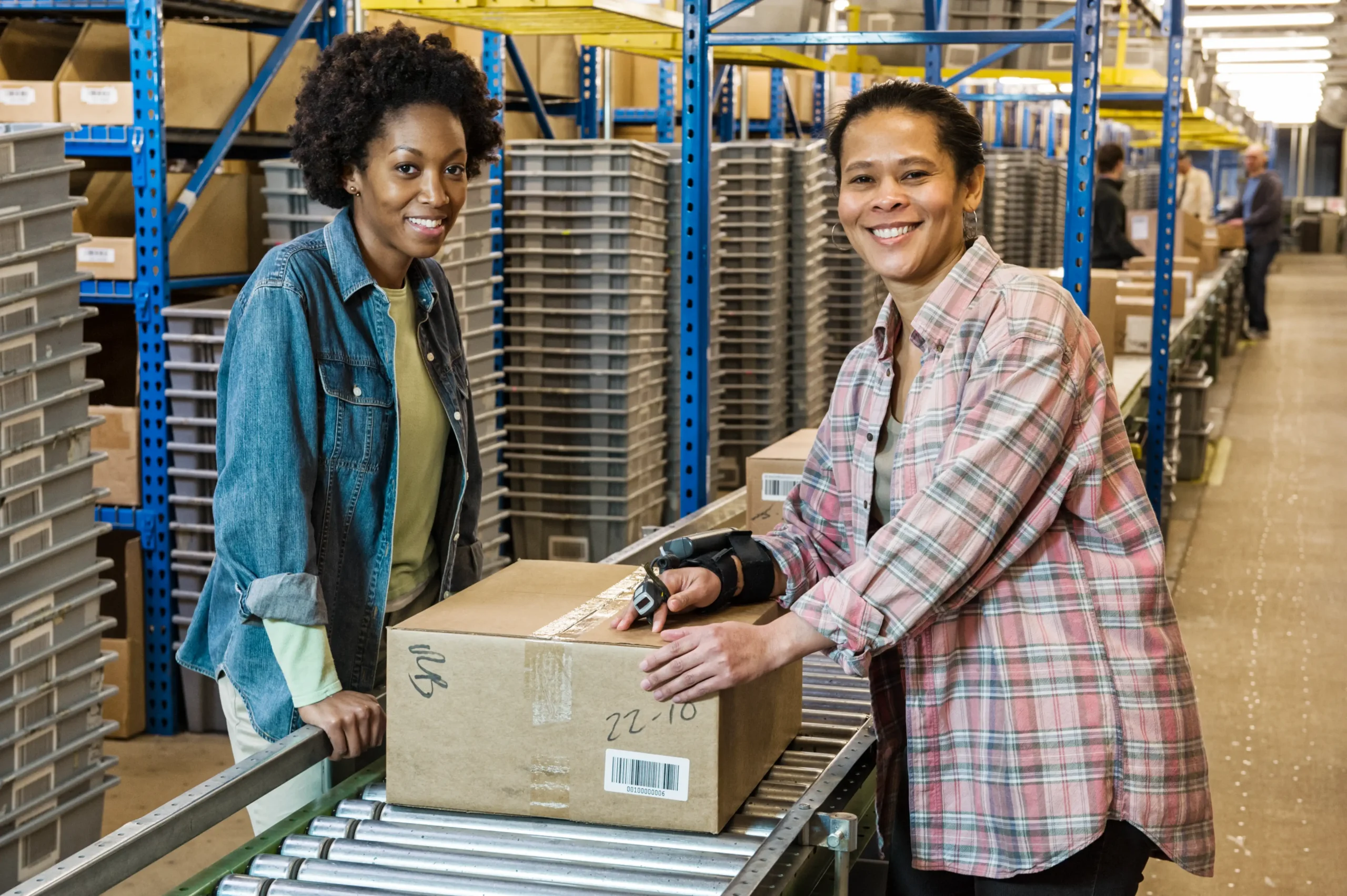Table of Contents
ToggleSupply chain technology refers to the integration of advanced tools and systems like artificial intelligence (AI), the Internet of Things (IoT), blockchain, and robotics into supply chain operations. These innovations enable real-time tracking, predictive analytics, and automation, making logistics smarter and more efficient.
At Tri-Link FTZ, we’ve been helping businesses leverage such technologies for over 35 years. From automating inventory management in foreign trade zones to streamlining global distribution, supply chain technology has become the cornerstone of modern logistics.
This term encapsulates the tools that connect every aspect of supply chains—linking suppliers, manufacturers, warehouses, and customers to ensure smooth operations.

The advancements in supply chain technology are nothing short of revolutionary. Artificial intelligence and machine learning stand out as transformative forces. These tools analyze complex data sets to predict demand, optimize routes, and forecast potential disruptions.
For instance, we’ve seen clients reduce lead times by 20% simply by integrating AI-powered demand forecasting tools. The Internet of Things (IoT) has also elevated supply chains.
IoT devices monitor shipments in real time, tracking temperature, humidity, and location. This has proven vital for industries like pharmaceuticals and food, where conditions can make or break a shipment.
Blockchain technology ensures transparency and security, creating tamper-proof records of transactions and goods. Robotics, on the other hand, automate repetitive tasks like picking, packing, and sorting in warehouses, significantly reducing errors and improving efficiency.
Finally, digital supply chain twins simulate operations, allowing businesses to test scenarios and plan for contingencies. Read more here.
The benefits of supply chain technology go far beyond operational efficiency. For one, it enhances visibility across the entire supply chain.
At Tri-Link FTZ, we’ve implemented systems that provide real-time data on inventory levels, helping businesses make informed decisions and avoid overstocking or understocking. Cost reductions are another major advantage.
Automation minimizes labor-intensive tasks, while predictive analytics optimize transportation routes, reducing fuel consumption and logistics expenses. These savings not only improve profitability but also enable competitive pricing.
Customer satisfaction also improves with faster delivery times and accurate tracking. Today’s consumers expect speed and transparency, and supply chain technology ensures that businesses can meet these expectations consistently.
Furthermore, the scalability of supply chain technology allows businesses to expand globally without losing operational efficiency. We’ve supported clients in entering new markets while maintaining seamless operations, thanks to tech-enabled processes.
Despite its benefits, adopting supply chain technology comes with challenges. The initial costs can be significant, especially for small businesses.
However, the long-term ROI often outweighs these upfront expenses. Integration with existing systems is another hurdle.
Legacy software may not be compatible with newer technologies, requiring businesses to overhaul their systems. At Tri-Link FTZ, we guide our clients through phased implementations to minimize disruptions.
Cybersecurity risks also loom large in interconnected supply chains. As data flows increase, so do the threats of breaches and ransomware.
Businesses must invest in robust security measures to protect sensitive information. Workforce resistance and training gaps can slow down adoption.
Employees accustomed to traditional methods may find it difficult to adapt to advanced tools. That’s why we prioritize workforce training in our implementations, ensuring teams are comfortable and confident with new systems.

Selecting the right supply chain technologies requires a strategic approach. Start by assessing your specific needs.
Are you looking to optimize inventory management, improve customer experience, or reduce costs? Next, identify technologies suited to your industry.
For example, IoT sensors are crucial for perishable goods, while blockchain excels in ensuring compliance in regulated sectors. Evaluate scalability and compatibility. Will the technology grow with your business?
Can it integrate seamlessly with your existing systems? These questions are vital.
Finally, prioritize ROI. Look beyond initial costs and consider the long-term benefits.
Partnering with experienced vendors like Tri-Link FTZ ensures you get reliable tools with comprehensive post-implementation support.
Integrating supply chain technology successfully involves a structured plan. A phased implementation approach minimizes disruptions.
Start small with pilot projects, address specific pain points, and scale gradually. Seamless integration with existing workflows is critical.
At Tri-Link FTZ, we use cloud-based solutions to ensure compatibility and real-time updates. Workforce training is equally important.
Employees should feel empowered to use new tools, not overwhelmed. We provide hands-on training sessions to bridge skill gaps effectively.
Aligning technology with business goals ensures you’re not adopting tools just for the sake of it. Whether it’s reducing lead times or improving sustainability, every implementation should serve a clear purpose.
Building long-term partnerships with technology vendors adds another layer of security. Reliable vendors provide ongoing support, ensuring your systems evolve with technological advancements.
Visibility is a game-changer in modern supply chains. Real-time tracking tools provide instant updates on shipments, inventory levels, and production cycles.
This not only improves operational efficiency but also allows businesses to respond quickly to disruptions. At Tri-Link FTZ, we’ve implemented AI-driven analytics that transform raw data into actionable insights.
These tools help our clients predict demand, identify bottlenecks, and optimize resources. Enhanced communication is another benefit.
Supply chain technology connects all stakeholders, from suppliers to customers, ensuring transparency and collaboration. Predictive analytics also play a crucial role.
By analyzing historical and real-time data, businesses can anticipate issues before they escalate, whether it’s a supply shortage or a transportation delay. Finally, integrating decision-making processes with technology fosters agility.
Businesses can simulate scenarios, evaluate options, and implement solutions faster than ever before.

Sustainability has become a critical focus for businesses, and supply chain technology plays a vital role in achieving eco-friendly operations. Predictive analytics, for instance, reduces waste by improving demand forecasting.
Companies can avoid overproduction and minimize unsold inventory, which often ends up as waste. At Tri-Link FTZ, we’ve implemented IoT systems that monitor transportation routes and optimize delivery paths, reducing fuel consumption and emissions.
These tools not only lower environmental impact but also cut costs. Blockchain technology supports ethical sourcing and transparency, ensuring businesses comply with sustainability standards.
Customers today demand to know where their products come from, and blockchain provides a verifiable trail from source to shelf. Digital twins are also making waves in sustainability efforts.
By simulating supply chain scenarios, businesses can test eco-friendly practices before implementing them. This helps avoid costly mistakes while advancing green initiatives.
Furthermore, automated systems contribute to sustainable practices by optimizing resource use. For example, robotic sorters reduce material waste in warehouses, aligning operations with sustainability goals. Read more here.
Supply chain technology offers tailored solutions for various industries, and at Tri-Link FTZ, we’ve seen firsthand how these tools adapt to unique needs. In ecommerce, for example, AI and warehouse robotics streamline fulfillment, improving delivery speed and accuracy.
The healthcare industry benefits immensely from IoT devices, which monitor temperature and humidity for sensitive products like vaccines. Blockchain ensures traceability, preventing counterfeit drugs from entering the supply chain.
In the food and beverage sector, robotics handle high-speed packaging while IoT sensors ensure proper storage conditions, reducing spoilage. These technologies save time, money, and resources, all while maintaining quality standards.
Retailers leverage omnichannel tools powered by real-time inventory tracking, enabling seamless transitions between online and in-store shopping. Customers can check stock levels and even reserve items for pick-up, creating a smooth shopping experience.
Manufacturers rely on automation and digital twins for predictive maintenance and efficient production cycles. These technologies reduce downtime and maximize output, essential for meeting high consumer demand.
The results of adopting supply chain technology are tangible and impactful. One major benefit is cost reduction.
Automating labor-intensive tasks, optimizing transportation routes, and reducing inventory waste all contribute to significant savings. Lead times also improve drastically.
With real-time tracking and predictive analytics, businesses can streamline operations and deliver products faster. At Tri-Link FTZ, we’ve helped clients cut lead times by up to 30%, enhancing their competitiveness.
Order accuracy rates see a marked improvement as well. Technologies like robotics and AI reduce errors in picking and packing, ensuring customers receive the correct items every time.
This leads to fewer returns and higher customer satisfaction. Speaking of satisfaction, faster deliveries and transparent tracking systems build trust and loyalty among customers.
Meeting these expectations consistently can result in higher repeat purchase rates. Finally, the ROI on supply chain technology is undeniable.
By improving efficiency, reducing costs, and enhancing customer experience, businesses position themselves for sustained growth and profitability.

Staying ahead in the ever-evolving world of supply chain technology requires proactive measures. Attending industry events and conferences is one of the best ways to stay informed.
These gatherings offer insights into emerging trends and innovative solutions. Subscribing to reputable blogs and publications also helps.
At Tri-Link FTZ, we regularly engage with thought leaders and industry news to remain on the cutting edge. Networking with peers and experts fosters the exchange of ideas and best practices.
Joining forums or online groups can provide valuable insights into challenges and solutions others are experiencing. Investing in workforce development is equally important.
Ensuring your team is equipped with the latest skills and knowledge keeps your business competitive. Lastly, monitoring technological advancements and regulatory changes ensures your supply chain stays compliant and innovative.
Businesses that adapt quickly to new opportunities and requirements are the ones that thrive in a competitive landscape.
The transformative power of supply chain technology cannot be overstated. From improving efficiency and visibility to enhancing sustainability and scalability, these tools are reshaping the logistics landscape.
At Tri-Link FTZ, we’ve seen the profound impact of adopting these technologies, and our 35 years of experience have positioned us as leaders in the field. By integrating advanced tools like AI, IoT, and blockchain, businesses can unlock new opportunities, overcome challenges, and achieve measurable success.
Whether you’re looking to optimize operations, expand globally, or enhance customer satisfaction, supply chain technology is the key to staying ahead. Take the first step toward a smarter, more efficient supply chain.
Partner with Tri-Link FTZ to leverage our expertise and cutting-edge solutions tailored to your business needs. Let’s build the future of logistics together.
Share this article
We have other resources available upon request as well as one-on-one support and personalized answers, just like our services.
Simply contact us anytime and we’ll get back to you to answer your questions and provide meaningful answers that show you how Tri-Link supports your logistics, reduces costs, and accelerates efficiency.
Tri-Link delivers exceptional FTZ and 3PL services tailored to your global trade needs.
Our solutions combine innovation, quality, and efficiency to exceed your expectations and meet your specific requirements.